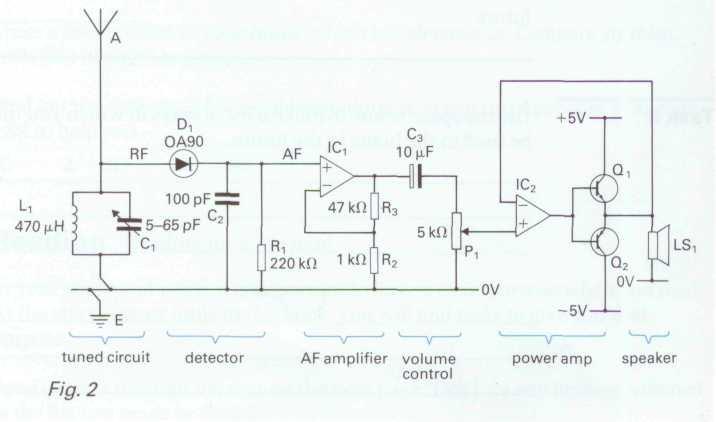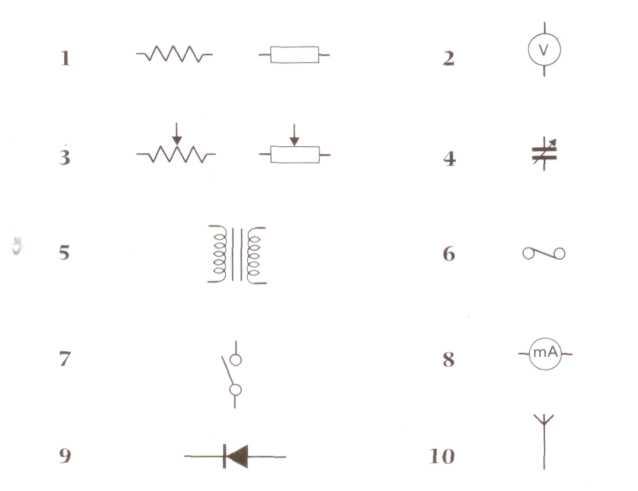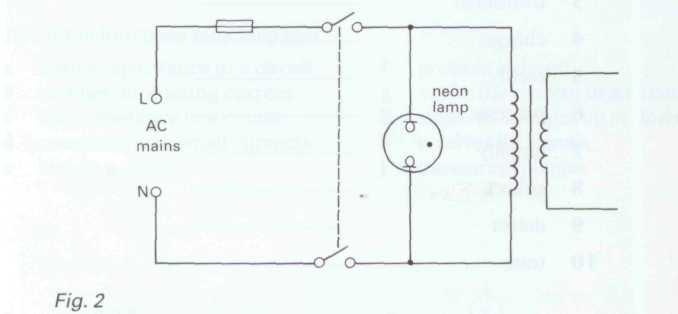
- •Part 1 Unit 1: Computers
- •Vocabulary
- •Exercises
- •Word study
- •Vocabulary
- •Exercises
- •Unit 2: New Technologies
- •Vocabulary
- •Exercises
- •Unit 1: Electronics. Electronic diagrams
- •Unit 2 : Transistors
- •Vceo and Vces
- •Part 3 Unit 1: Controllers
- •256 I/o points
- •750Kbps
- •Unit 2: Sensors
- •2. Psychrometrics & moisture
- •3. Humidity Sensor hih-3610 Series
- •Literature
Unit 1: Electronics. Electronic diagrams
Text A Electronics in the home
Task 1
Make a list of things in your house which use electronics. Compare your list with that of another group.
Task 2
Find out the meaning of these abbreviations. You can use Appendix 1? to help you.
1 IС 2 CD 3 hi-fi
Task 3
Reading for a purpose
Read quickly through the following text. Tick [] any items mentioned in the list you made in Task 1.
Electronics in the home
Electronics began at the start of the twentieth century with the invention of the vacuum tube. The first devices for everyday use were radios, followed by televisions, record players, and tape recorders. These devices were large and used a lot of power.
The invention of the transistor in 1947 meant that much smaller, low-powered devices could be developed. A wide variety of electronic devices such as hi-fi units and portable radios became common in the home.
It was not until 1958 that microelectronics began with the development of ICs (integrated circuits) on silicon chips. This led to a great increase in the use of electronics in everyday items. The introduction of the microprocessor allowed electronics to be used for the control of many common processes.
Microprocessors are now used to control many household items such as automatic washing-machines, dishwashers, central heating systems, sewing machines, and food processors. Electronic timers are found in digital alarm clocks, water heaters, electric cookers, and microwave ovens. Telephones use electronics to provide automatic dialling and answerphone facilities. New entertainment devices have been developed, such as video recorders and CD (compact disc) players.
In the future, electronics are likely to become even more common in the home as multimedia entertainment systems and computer-controlled robots are developed.
Task 4
Fill in the gaps in this table with the help of the text.
|
Date |
Invention |
Applications in the home |
|
early 20th century |
|
|
|
|
transistor |
|
|
1958 |
|
automatic washing-machines, |
|
future |
|
|


 Task 5
Task 5
Make a list of ways in which you think electronics may be used in the home in the future.
Text B Understanding diagrams
In electronics, you have to read not only texts, but also diagrams. You have to be able to combine information from both diagram and text. This text introduces two kinds of diagrams often used in electronics.
Task 1
Read the text below to find the answers to these questions:
1. What do we call the two types of diagrams shown in the text?
2. What do we call the approach to electronics which focuses on the function of units?
Understanding electronic diagrams
Although electronic devices may look complicated, they are made up of common basic units ('building blocks') connected together. The function of each of these units and the path of the signals between them can be shown in a block diagram. For example, the block diagram of a simple radio is shown in Fig. 1.

To understand how the radio works, it is more important to understand the function of each unit than to know what components are used. This is known as a systems approach to electronics. For example, in Fig. 1 the tuner selects the required signal, the detector then separates off the audio part of the signal, and the AF amplifier (amp) amplifies it.
The connections and values of the components inside these basic units can be shown in a circuit diagram using standard electronic symbols. Fig. 2 shows the circuit diagram for the simple radio.

Task 2
How many of the circuit symbols in Fig. 2 can you identify? Use Appendix 2 to help you.
Language study Describing components
Two questions we may need to answer when we describe components are:
-
What is it called?
-
What does it do?
In other words, we need to be able to:
-
label components.
-
describe their function.
We can use these ways of labelling components:
It is called a Zinc-carbon cell.
It is known as a NiCad cell.
We can describe the function of components like this:
A cell provides electricity.
Cells change chemical energy into electricity.
Task 3
Here are some circuit symbols. Label them and describe their function. For example:
5 h It's called a transformer. It steps AC voltages up or down.
This list of functions may help you.
|
a |
varies capacitance in a circuit |
f |
protects a circuit |
|
b |
rectifies alternating current |
g |
varies the current in a circuit |
|
с |
adds resistance to a circuit |
h |
steps AC voltages up or down |
|
d |
measures very small currents |
i |
receives RF signals |
|
e |
breaks a circuit |
j |
measures voltages |

Task 4
Word Study Verbs and related nouns
Each of these verbs has a related noun ending in -er or -or which refers to an instrument or component. Complete the column of nouns, make sure you are able to understand their meaning.
|
|
Verb |
Noun |
|
Example |
record |
recorder |
|
|
1. oscillate |
|
|
|
2. transmit |
|
|
|
3. transform |
|
|
|
4. charge |
|
|
|
5. rectify |
|
|
|
6. process |
|
|
|
7. amplify |
|
|
|
8. collect |
|
|
|
9. detect |
|
|
|
10. tune |
|
Task 5
Technical reading Battery charger
Study this circuit diagram of a battery charger and try to name all the components.

Now read this text to check your answers:
The power to drive an electronic circuit is normally provided by an AC mains power supply but batteries are often used for portable equipment. Secondary cells can be recharged to their original voltage and can therefore be used many times over.
Recharging is done using a battery charger which consists of a mains power supply with a DC output slightly larger than the required battery EMF. A current is driven through the battery in the opposite direction to its normal output current. The block diagram of a battery charger is shown in Fig. 1.

The first stage consists of a transformer which steps down the voltage of the AC mains (see Fig. 2).

The charger is switched on and off by a double-pole switch connected in series with the mains input. A neon lamp, connected across the primary of the transformer, shows when the charger is on. A fuse is connected in the live side of the supply to protect the transformer.
The second stage is a bridge rectifier which converts the AC voltage to a DC voltage (see Fig. 3).

Language Study Describing block diagrams and circuits
Look again at Fig. 1 above. We can describe it like this:
|
The radio |
consists of is composed of |
a tuner, a detector, and an AF amplifier. |
Using comprise, we can start our description with the blocks:
|
A tuner, a detector, and an AF amplifier |
comprise |
the radio. |
We can describe the links between each building block using these expressions:
|
The tuner |
is connected to is linked to |
the detector. |
Look again at Fig. 2. We can describe the values of the components like this:
|
Rl |
a two-hundred-and-twenty-kilohm resistor |
|
C2 |
a hundred-picofarad (puff) capacitor |
Task 6
Describe the value of these components:
-
R2
-
C1
-
R3
-
C3
-
P1
-
L1
This table provides the terms you need.
|
Prefix |
Symbol |
Multiple |
Example |
|
giga |
G |
109 |
GHz gigahertz |
|
mega |
M |
106 |
M megohms |
|
kilo |
k |
103 |
kV kilovolts |
|
deci |
d |
10-1 |
dB decibels |
|
milli |
m |
10-3 |
mW milliwatts |
|
micro |
|
10-6 |
H microhenries |
|
nano |
n |
10-9 |
nF nanofarads |
|
pico |
p |
10-12 |
pF picofarads |
Looking now at the basic units of the circuit, we can describe the volume control like this:
The volume control consists of a ten-microfarad electrolytic capacitor connected in series with a five-kilohm potentiometer (pot). The positive terminal of the capacitor is connected to the output of the AF amplifier and the wiper of the pot is connected to the power amp. The third terminal of the pot is connected to the zero voltage supply rail, which is earthed.
Task 7
Fill in the gaps in this description of the tuned circuit shown in Fig. 2. Each gap represents one word.
The circuit ________________1 of a four hundred and seventy _______________2 inductor which is connected in parallel with a ________________3 capacitor. The ______________4 can be varied between five and sixty-five _______________5.The aerial is _______________6 to the top end of the tuner. It is also connected to the positive terminal of the __________________7 in the detector. The bottom end of the tuner is connected to earth via the zero voltage _________________8 rail.
Task 8 Speaking practice
Work in pairs, A and B. Complete your circuit diagram with help from your partner.
Ask questions like these:
What kind of component is P1?
What's the value of С1?
What is connected between the collector of Q2 and the positive side of the battery?
If you don't understand your partner, say:
I'm sorry, I don't understand. Could you say that again, please? Could you speak more slowly?
If your partner doesn't understand you at first, try phrasing your answer in a different way. For example:
It's a variable resistor. It's a resistor which you can vary or change by turning the control. It's called a variable resistor.
Student A: Your circuit diagram is on page 174
Student B: Your circuit diagram is on page 181.
Task 9 Writing Describing diagrams
With the help of the diagram, fill in the gaps in the description of Figure 3.
Each gap represents one word. The description should answer these questions:
-
What is the diagram of?
-
What does it consist of in terms of blocks?
-
How are the blocks connected?
-
What is the function of each block?

Fig. 3 shows the block diagram of an amplitude-modulated (AM) radio transmitter. It _________________1 of a radio frequency (RF) oscillator, a __________________2, an audio frequency (AF) amplifier, and an RF power amplifier.
The RF _______________3 generates an RF ________________4 wave which is fed into the modulator.
The microphone converts sounds into audio frequency signals which are amplified by the AF _________________5.The modulator then uses the amplified AF ________________6 to modulate the RF carrier wave.
The power of the modulated carrier wave is increased by the RF _____________7 amplifier. The strong modulated output signals are fed to the _______________8 which enables them to be transmitted over long distances.
Task 10 Grammar
Complete the text about developments in radio and television. Put the verbs in brackets in the correct form: Past Simple or Present Perfect.
In just over a hundred years, radio ______________ 1 (develop) into a major form of entertainment and communication. Marconi ______________2 (invent) a wireless telegraph system in 1896. This _______________ 3 (be) the birth of radio. Voice transmission ______________ 4 (start) in 1909 following the invention of the valve. Semiconductors _________ 5 (make) it possible to develop much smaller, portable radios. The introduction in recent years of digital radios ___________ 6 (allow) us to enjoy much better sound quality. There ________________ 7 (be) many changes in television too. In the UK, the BBC _______________ 8 (start) daily TV broadcasts in 1936. Colour broadcasts _____________ 9 (begin) in the late 1960s. Since the 1970s satellite broadcasting ____________________ 10 (allow) viewers a wider choice of programmes. The recent introduction of digital TV ____________ 11 (mean) better picture and sound quality. Manufacturers now ____________12 (develop) entertainment systems which include television, radio, DVD recorder/player, and computer. The Internet ___________________ 13 (make) it possible to enjoy radio and television from around the world on our PCs.
